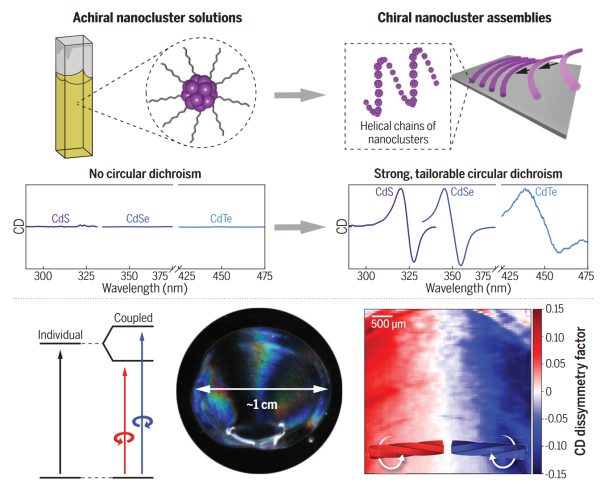Transforming achiral semiconductors into chiral domains with exceptional circular dichroism
The creation of mesoscale chiroptic materials from nanoscale achiral building blocks has been previously realized, but extending excitonic chirality to inorganic semiconducting systems has remained elusive. Among the many challenges to achieving this goal is the need for degenerate excited electronic states, which are difficult to obtain in nanocrystals with nonzero size distributions, and the requirement for aligned transition dipoles, unlikely characteristic in spherical nanocrystals that lack a distinct axis. This goal is consequential, as introducing chirality into the band structure of semiconductors enables simultaneous control over light, spin, and charge, key capabilities for driving innovations in next-generation photonic, optoelectronic, and spintronic technologies.
In this collaborative work, a method to form chiral films of three different inorganic semiconductor nanocrystals, with near-limit dissymmetry factors and large homochiral domains is reported. The mechanism behind these organized assemblies is elucidated through linear dichroism, small-angle x-ray scattering carried out at the CFM, and in situ microscopy. Structural results for three different semiconducting nanocluster systems demonstrate the generality of the method, suggesting the applicability to other nanocluster species or colloidal nanoplatelets. The experiments uncovered the key mechanisms for achieving these chiroptic films by the meniscus-guided deposition process, including the alignment of transition dipoles of the constituents and the fluid flows responsible for twisting the fibers, and make a connection to emergent chiral properties. Harnessing methods to form chiral films from achiral, solution-processable semiconductors offers an opportunity in the design and fabrication of complex chiroptical metamaterials in ways that are both scalable and versatile. Beyond nanocluster films, this study provides valuable insights into the complexities of hierarchical assembly found in nature and offers a pathway to extend these principles to other chiral molecules and nanomaterials for engineering sophisticated, twisted structures.

Chiral assemblies from achiral nanoclusters. Semiconducting magic-sized nanoclusters can form helical assemblies through meniscus-guided deposition. Degenerate excited states split into nondegenerate states upon coupling, producing exciton couplets in CD spectra. Controlling the evaporation geometry produces high-fidelity films with handedness imparted onto the fibers, forming various domain shapes and sizes with homochiral domains exceeding 6 mm2 that transition smoothly between left- and right-handed chirality.



